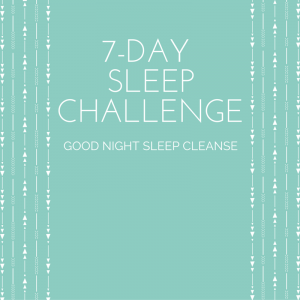The Good Night Sleep Cleanse™
You just started another nutritional cleanse. You’re chugging down your smoothies and researching the latest gluten free, sugar free, organic kale recipe. You’ve renewed your gym membership and you’re on target for your next triathlon. You are ready. Ready to make changes. Ready to put YOU first. You are going to work towards optimal health.
Before you start though let me ask you a question?
How well do you sleep?
I ask you this because if you aren’t sleeping well – or enough – all the quinoa and spin classes in the world won’t be enough to achieve your health success. Sleep is one of the 3 Pillars of Health, along with nutrition and exercise, and if I may be so bold in saying it’s the foundation of the two. Without it you aren’t going to make smart nutritional choices and you’ll have no energy to workout.
So sleep is pretty important, right? Yet it’s always last on our list, low on the totem pole, never a priority and completely taken for granted.
Well I say it’s time to put it first because doing so will be truly putting yourself first. The Good Night Sleep Cleanse™ is your first step towards a healthier you and our seven-step sleep cleanse will help you achieve better sleep for you and your family. Are you ready? Let’s do this!

The Good Night Sleep Cleanse™
Step One:
I want each of you to follow a more consistent sleep pattern – meaning for the next 7 days you are going to go to bed and wake up at the same time every day – even on the weekends. On average you should be getting 7-8 hours of sleep per night so depending on when you need to wake in the morning adjust your bedtime accordingly. This may be one of the most important steps in this challenge because when we consistently synch our sleep with our natural sleep rhythms and 24-hour biological clock we are able to achieve the best restorative sleep possible and going to bed and waking up become easier. Stop setting your alarm to wake up. Set it to go to bed!
Step Two:
Join the movement and #BringBackBedtime. Following a consistent bedtime routine prepares your body to sleep and helps release your own natural sleep hormone melatonin. Follow Good Night Sleep Sites initiative in bringing back bedtime between you and your child, you and your partner, and with yourself!
Step Three:
Set up your sleep environment for sleep success. Start off by clearing out the clutter. You bedroom should be for sleep only. It’s not your workout gym or office. Promote a cave-like environment and make sure your bedroom is dark, quiet, and cool. Installing blackout blinds, running a white noise machine and keeping temperatures cool will help you achieve proper restorative sleep. And lastly give your mattress an audit. It’s the single most important piece of furniture in the home. You should be re-evaluating your mattress every 5 years. If you are having difficulty sleeping your mattress could be the culprit.
Step Four:
Do you want to know what is one of the biggest sleep disruptors out there? Tech! We are always connected – on our computers, phones, and tablets. They have replaced our paperback novels and have started to make their way into out bedrooms. The blue lights of your screen suppress your melatonin and turns your light switch off. So kick tech to the curb. Get it all out of the bedroom. Your TV included. Create a family docking station in a room of your home and #JustDockIt! Electronics should be turned off at least 60 minutes before bedtime and 90 minutes if you can do it.
Wondering how to create your own family docking station? Check out the one I made for my family.
Step Five:
When analyzing my clients sleep diaries a common culprit of insomnia is spending too much time in bed not sleeping. It’s important that our bed is associated with sleep and to strengthen that association a few things need to happen.
- As discussed in step one, following a consistent sleep schedule where you are going to bed when your body is ready to. This will make it easier to fall asleep and you won’t be lying in bed awake for too long. To determine your correct bedtime – calculate 7-8 hours back from your natural wake time in the morning, or when you have to get up in the morning. If you find you are still struggling to fall asleep at night move bedtime later by 15 minutes each night until it takes you between 10-15 minutes to fall asleep. As you body adjusts to this consistent bedtime and waketime (even on the weekends), and the bed=sleep association gets stronger, you will be able to move bedtime slightly earlier again if need be.
- If you wake up in the middle of the night and can’t fall back to sleep, take the pressure off and get out of bed. This is such a common complaint with my insomnia clients and can be an ongoing struggle with an individual. Here’s what happens. You have trouble falling asleep or you wakeup and can’t fall back to sleep and now all you can think about is that you’re not sleeping and you should be sleeping but you can’t fall asleep and ack! – the mind starts spinning. I give you permission to get out of bed and remove yourself from the stress of the whole thing entirely. Go into a different room but keep things quiet and dark. Don’t start turning on every light and whatever you do don’t turn on the TV or check your emails. Read a chapter or two in low light, drink a warm glass of milk, listen to soothing music, or try some adult colouring. Try again after 20 minutes or so and continue the process until you can fall asleep. The more nights you do this the easier it will be for you to fall back to sleep and getting out of bed won’t be necessary anymore.
Step Six:
Shutting off the brain and keeping worries at bay long enough for us to drift off to sleep can be difficult. Keep a journal on your night table that can be used in a few ways. If you find that you are in a highly anxious or stressful period of your life write down all your worries before you go to bed. Get them out of your head so that you can go to bed worry free. I also recommend using a journal to jot down business ideas, creative ideas, or fun things to do with the kids as soon as you wake up. Try and compare your morning journal entries from when you’ve had a great night of sleep to those when you haven’t had enough sleep. You’ll likely see a difference in quality of entries.
Corporate Sleep Workshops
Step Seven:
Often our relationship with sleep and how we view our sleep can affect how we sleep. If during our sleep struggles we’ve created a negative relationship with sleep or continuously think negative thoughts about sleep; “I’ll never sleep well again,” “I know I’m going to have a hard time falling asleep,” “I’m going to feel awful all day tomorrow,” it’s only going to feed into your sleep struggles and fuel them to continue. We have to change the way we think about sleep. Sleep train our brains if you may. Turn your negative thoughts into positive ones by choosing a few positive sleep affirmations that you can repeat to yourself throughout the day. Your list can include:
“I have always been a good sleeper.”
“I think I’m doing much better these days.”
“I am functioning just fine on not that much sleep.”
“I love my bed and I love to sleep there.”
Even if these aren’t true at the moment it doesn’t matter. It will become true once we exercise our mind to think it and believe it. Set aside time three times a day to sit down for 10 minutes and run through your affirmations. Say them out loud. Say them into the mirror. Record it on your phone and listen to yourself saying it. If you like reminders, write them on Post-It notes and stick them on the bathroom mirror or the refrigerator. Let the positive thoughts about your sleep slowly begin to take over the overwhelming negative thoughts. Practice makes perfect. The negative thoughts will not disappear overnight, or even during the 7 days of this cleanse. If you commit to truly practicing these positive affirmations you will see results in 3 to 4 weeks.
I wanted to provided you with seven sleep tips for The Good Night Sleep Cleanse™ that are easy to try and realistic to incorporate into your lifestyle but I feel it’s important to leave you with one more.
Don’t ignore the snoring.
If you or your partner frequently snore or feel you are following a pretty healthy sleep routine and schedule but still feel groggy and tired when you wake up and throughout the day talk to your doctor. They are the first step in getting you a referral to have a sleep study done for possible sleep apnea. Along with insomnia, sleep apnea is one of the leading sleep disorders. Know the signs and symptoms and talk to your doctor.
Provided you fully commit to The Good Night Sleep Cleanse™ and make it part of your day-to-day, you will see the sleep results you want to. Complete the 7-days but if you can instead incorporate these tips always you’ll have a better chance of consistently hitting your basal sleep needs and remaining well-rested for the rest of your life.
You may even notice those last 10 pounds you were so desperately trying to lose suddenly start to fall off.
And you can thank sweet, sweet slumber for that.
Are you taking The Good Night Sleep Cleanse?
Are you taking The Good Night Sleep Cleanse? I want to know! Follow me on Facebook, Twitter, and Instagram and let me know by giving me an update using #GoodNightSleepCleanse and tagging me with @GNSleepSite.

Alanna McGinn is a Certified Sleep Consultant and Founder of Good Night Sleep Site – a Global Pediatric and Family Sleep Team. She provides free child and family sleep support through Facebook, Twitter, and Instagram. She invites you to join her sleep community as she works towards Good Night Sleep Site’s mission of a healthier rested family unit. For more sleep tips please visit Good Night Sleep Site. Join our movement and #BringBackBedtime.
